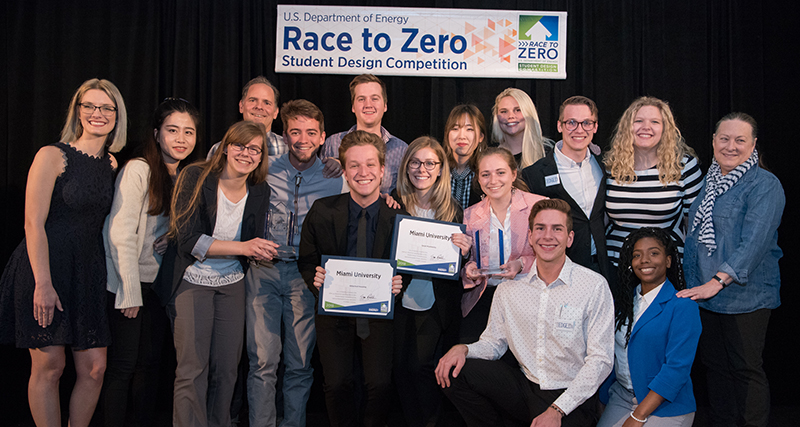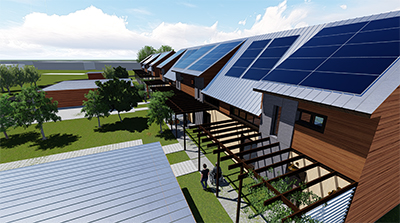Miami students place in annual U.S. Department of Energy design competition


Two multi-disciplinary teams of Miami University students have won first and second place awards in the 2018 U.S. Department of Energy Race to Zero Student Design competition.
The Race to Zero is an annual competition, open to students and faculty from collegiate institutions worldwide. The competition encourages students to work with builders, developers, community leaders, and other industry partners to meet stringent design requirements and create marketable, affordable concepts.
Seventeen students from architecture and mechanical engineering majors collaborated in the 2018 Race to Zero competition studio. The studio fielded two teams in the first phase of the competition. In March, their progress entries were selected to be among the 40 finalist teams representing 34 institutions from the U.S. and internationally. The Miami students presented their final proposals at the National Renewable Energy Laboratory (NREL) April 21-22 in Golden, Colorado. Miami’s EcoEdge team won first place in the small multifamily contest. Miami’s Optimize team won second place in the attached housing contest.
The Teams and the Projects

Team EcoEdge project submission: Freedom's Path to Zero
Miami’s team EcoEdge competed in the small multifamily category. They developed an innovative design for a 60-unit building to house homeless veterans on the VA Medical campus in Chillicothe, Ohio. After touring an existing veterans housing facility on the site and learning of the high demand for veterans housing, the students were inspired to design a neighboring building to provide the additional housing. Their project, Freedom’s Path to Zero, is envisioned as a high-performance, transformative space to serve veterans’ needs with specific goals for universal design, interior environmental quality, privacy, community, and access to health resources. The ultra-low energy design is achieved through strategies of compartmentalization, high-performance building envelope, decentralized geothermal heating and cooling system with energy recovery ventilation, and photovoltaic systems. In addition to efficient, healthy and accessible apartments, the project features many common spaces where veterans can find community: An open-air roof terrace is shaded by PV panels, a ground-floor community room, outdoor patio.

Team Optimize project submission: The Wright Path to Zero
Miami’s team Optimize competed in the attached housing category. They developed a new vision for military family housing, choosing the Properties at Wright Field in Dayton, Ohio as their site. After studying the unique needs of military families, the students designed a new prototype for attached housing centered on concepts of community and universal design. Their project, The Wright Path to Zero, challenges the traditional format of a cul-de-sac. The four-unit houses are arranged in unique linear layout that creates an internal “community garden courtyard” to promote a walkable and interactive community. The buildings are aligned along an east-west axis with windows and roof overhangs that optimize daylight inside the homes. The ultra-low energy design is achieved through strategies of high-performance building envelope, daylight optimization, ducted mini-split heating and cooling system with energy recovery ventilation, and a micro-grid photovoltaic with on-site battery storage. Residents are encouraged to monitor and adjust their energy and water usage as well as stay informed about community events through a customized smartphone interface.
The teams used energy modeling in their process to arrive at designs that meet climate-specific performance targets for carbon and energy reduction and healthy indoor air quality as established by the Passive House Institute US (PHIUS) Passive Building Standard. Passive House guiding design principles include Super insulated walls, Air tightness, Balancing the loss and gains in energy, Minimize thermal bridging from the construction, High performance windows and Renewable energy. Both Freedom’s Path to Zero and Wright Path to Zero projects met or exceeded the net zero energy target through the provision of photovoltaic solar panel arrays that produce enough energy on-site to offset the buildings predicted annual energy use.
Both housing proposals are designed to be 100% accessible and employ Universal Design principles which seek to create a built environment that is usable to the greatest extent possible by everyone regardless of their age, status in life, ability, or disability.
The student teams were advised by industry partners including Heapy Engineering, Green Building Consulting, Prosoco, Ultimate Air, and Miller Valentine Group. The 2018 Race to Zero studio was led by John Becker with consulting faculty advisors Mary Rogero and Mary Ben Bonham (architecture and interior design), Padmakar Niskode and John Richter (mechanical and manufacturing engineering). Miami students first entered the competition in 2017, bringing home a second-place win in the multifamily contest in that inaugural effort.

